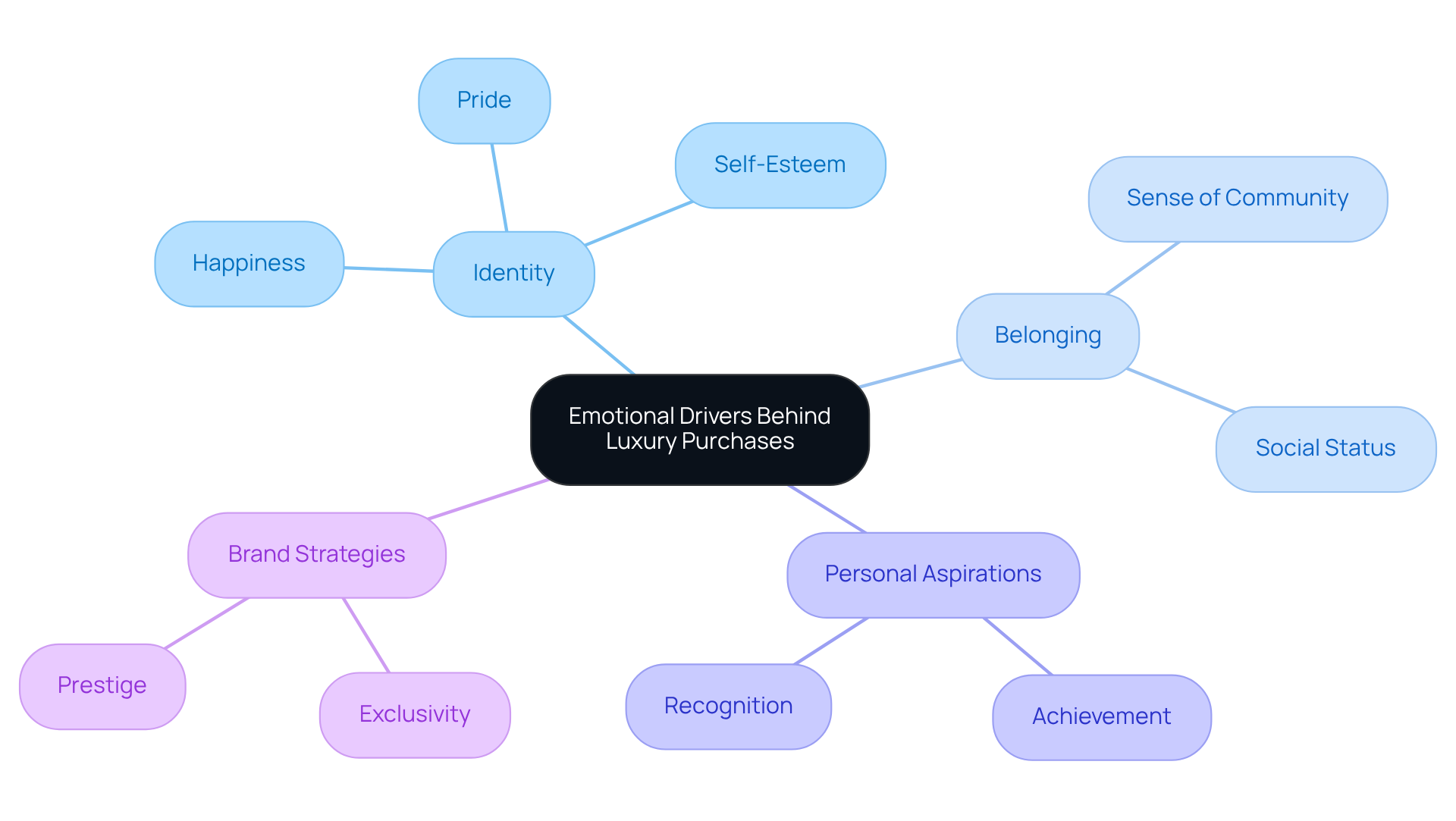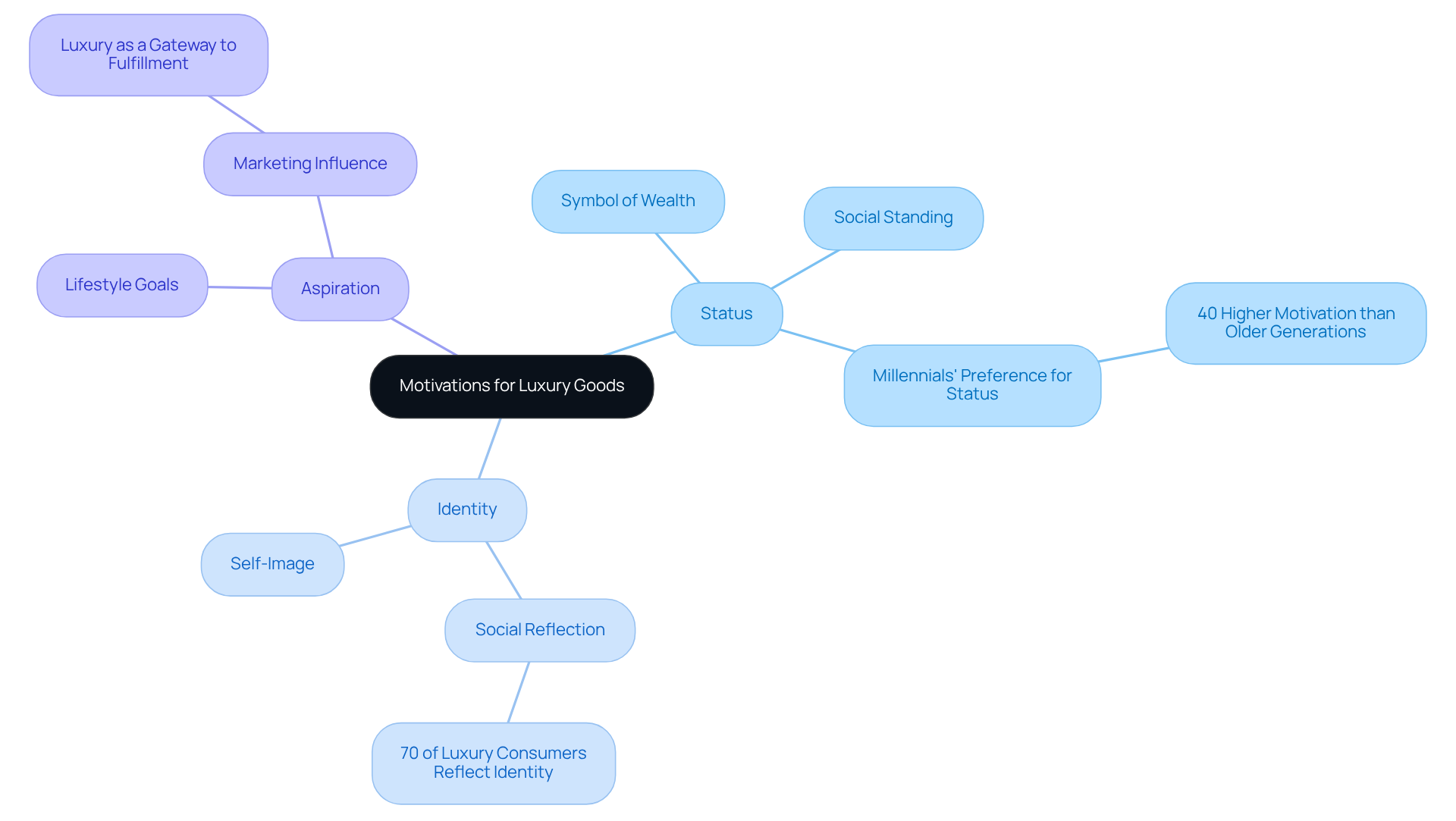Overview
The emotional drivers behind luxury goods purchases often stem from a deep-rooted desire for identity, status, and personal aspiration. Many consumers seek these items as a means to express their social standing and fulfill their self-image.
It's important to recognize that, for a significant portion of affluent buyers—approximately 70%—luxury purchases are seen as reflections of their identity. This highlights a critical aspect: emotional satisfaction often takes precedence over practical needs when it comes to luxury consumption.
By understanding these motivations, we can better appreciate the complexities of why individuals choose to invest in luxury goods, ultimately fostering a deeper connection with their aspirations.
Introduction
The allure of luxury goods often transcends mere material possession, tapping into profound emotional currents that shape our behavior. As we navigate our identities and aspirations, the desire for status and belonging can drive us toward high-end purchases that promise not just products, but a reflection of our self-worth. Yet, this pursuit raises critical questions:
- Do these luxuries genuinely enhance our personal fulfillment, or do they merely mask deeper insecurities?
Exploring the intricate motivations behind luxury consumption reveals a complex interplay of emotions, societal pressures, and the quest for authenticity in a world increasingly defined by materialism. It’s essential to recognize these feelings and understand how they affect us, fostering a deeper connection with our true selves.
Understand Emotional Drivers Behind Luxury Purchases
Purchases of luxuries goods often stem from deep emotional factors that go beyond functionality or necessity. Many consumers seek luxuries goods to express their identity, find a sense of belonging, or fulfill personal aspirations. Emotions like happiness, pride, and self-esteem are closely tied to the ownership of luxuries goods. Remarkably, studies reveal that 70% of high-end buyers are motivated by feelings of satisfaction rather than their practical needs for luxuries goods. This highlights just how significant these emotions are in their purchasing decisions.
As Steve Markov insightfully notes, "Now that consistently assessing sentimental ties between buyers and companies on a large scale is no longer difficult, high-end product marketers can genuinely comprehend and utilize this valuable information to guarantee that their offerings occupy a distinct position in the thoughts and feelings of their clientele."
Brands that nurture this personal connection often employ branding strategies that evoke feelings of exclusivity and prestige through luxuries goods, making individuals feel unique and valued. For example, high-end brands like Tiffany & Co. have mastered the art of creating emotional connections, fostering a strong bond between affection for luxuries goods and consumer behaviors, including a willingness to pay more.
Furthermore, Gallup's research shows that emotional factors account for 65% to 70% of the variance in customer engagement, underscoring the importance of satisfaction in luxuries goods marketing. By understanding , companies can tailor their marketing strategies to resonate more deeply with their target audience, ultimately enhancing customer loyalty and engagement. This approach not only builds a stronger relationship with customers but also empowers brands to thrive in a competitive landscape where emotional fulfillment is essential.

Explore Key Motivations: Status, Identity, and Aspiration
The motivations for acquiring luxuries goods often stem from a relatable concern: the desire for status, identity, and aspiration. Status, in particular, can feel like the most pressing incentive; luxuries goods serve as symbols of wealth and success, enabling individuals to express their social standing to others. Consider a tech startup founder who chooses a high-end smartwatch—not solely for its features, but to project an image of innovation and achievement. Interestingly, Millennials show a motivation for high-end products that is about 40% greater than that of older generations, highlighting how crucial status is for younger consumers.
Identity also plays a significant role; many individuals gravitate towards luxuries goods and high-end brands that resonate with their self-image or the persona they wish to present. Approximately 70% of affluent buyers express that their purchases of luxuries goods reflect their identity and social standing, underscoring the importance of this theme. Furthermore, aspiration serves as a powerful motivator; numerous consumers invest in luxuries goods as a means to reach for a lifestyle they admire. This longing is often fueled by marketing narratives that depict high-end items as gateways to a more fulfilling life.
However, it is essential for high-end brands to tread carefully, maintaining an exclusive aura while avoiding the pitfalls of overexposure or excessive branding. By understanding these motivations, brands can craft messages that resonate with people's dreams and desires, ultimately fostering deeper connections and enhancing brand loyalty. As David Dubois insightfully notes, 'Consumers’ enduring drive for luxuries goods largely comes from the need for status.'
Yet, we must also recognize the psychological complexities tied to high-end consumption, such as feelings of inauthenticity, which can complicate consumer behavior in the luxury market. By acknowledging these nuances, brands can better support their customers, creating that addresses both emotional and practical needs.

Analyze Consequences of Luxury Consumption on Self-Perception and Society
The consumption of luxuries goods presents a significant challenge for many, influencing not only personal self-perception but also societal values. On a personal level, owning high-end items can boost self-esteem and cultivate a sense of accomplishment. Yet, this pursuit can also stir feelings of inadequacy or anxiety, particularly when individuals feel the weight of maintaining a certain lifestyle or image.
Consider, for instance, the remarkable growth of the luxuries goods market, which has surged from $226.61 billion in 2013 to an estimated $346.19 billion in 2023. This trend reflects a rising demand for luxuries goods, but it also raises important questions about our self-worth and societal pressures.
As we navigate this landscape, it’s essential to recognize that the consumption of luxuries goods often deepens class distinctions and fuels materialism. Many individuals may find themselves equating their value with the ownership of luxuries goods, creating a cycle of pressure to continuously upgrade their possessions to meet societal expectations.
As highlighted by Husic & Cicic, the aspiration for status and social influence propels individuals toward . The advent of social media has only intensified these dynamics, showcasing affluent lifestyles that can shape buyer behavior and aspirations. Digital platforms play a crucial role in influencing purchasing decisions, particularly in markets like China, where online shopping is prevalent.
By reflecting on these consequences, brands can gain valuable insights into the societal context in which they operate. This understanding allows them to craft strategies that not only enhance positive consumer experiences but also mitigate potential negative impacts, fostering a community where individuals feel valued beyond their possessions.

Conclusion
Understanding the emotional drivers behind luxury purchases reveals a significant issue: consumers are often motivated by deeper psychological needs rather than mere practicality. Many individuals find themselves on a quest for identity, status, and aspiration, seeking to express their self-image and social standing through luxury goods. This emotional connection highlights the importance of satisfaction in the luxury market, where feelings of pride and belonging can often overshadow functional considerations.
It’s striking to note that a staggering 70% of affluent buyers make their luxury purchases based on emotional fulfillment. Brands that effectively tap into these sentiments—crafting narratives of exclusivity and prestige—can cultivate strong consumer loyalty. However, the interplay between personal self-perception and societal values adds complexity to luxury consumption. Many navigate feelings of inadequacy and the pressures of maintaining a certain lifestyle in a materialistic society, which can be overwhelming.
Ultimately, the implications of luxury consumption extend beyond individual buyers; they mirror broader societal trends and values. As brands evolve their marketing strategies, it becomes essential to consider not just the motivations of consumers but also the potential impacts on self-worth and social dynamics. By encouraging a culture that values individuals for more than their possessions, we can foster a more balanced approach to luxury consumption, promoting emotional well-being alongside brand loyalty. Let’s embrace this journey together, supporting one another in finding value beyond material goods.
Frequently Asked Questions
What are the emotional drivers behind luxury purchases?
Luxury purchases are often driven by deep emotional factors such as the desire to express identity, find belonging, and fulfill personal aspirations. Emotions like happiness, pride, and self-esteem are closely tied to the ownership of luxury goods.
How significant are emotions in the purchasing decisions of high-end buyers?
Studies show that 70% of high-end buyers are motivated by feelings of satisfaction rather than practical needs for luxury goods, highlighting the importance of emotions in their purchasing decisions.
How can brands leverage emotional connections in their marketing strategies?
Brands can nurture personal connections by employing branding strategies that evoke feelings of exclusivity and prestige, making consumers feel unique and valued. This can enhance customer loyalty and engagement.
What role does customer engagement play in the luxury goods market?
Emotional factors account for 65% to 70% of the variance in customer engagement, indicating that satisfaction is crucial in luxury goods marketing.
Can you provide an example of a brand that successfully creates emotional connections with consumers?
Tiffany & Co. is an example of a high-end brand that has mastered the art of creating emotional connections, fostering a strong bond between affection for luxury goods and consumer behaviors, including a willingness to pay more.
How can understanding emotional drivers benefit companies in the luxury market?
By understanding psychological drivers, companies can tailor their marketing strategies to resonate more deeply with their target audience, ultimately enhancing customer loyalty and helping brands thrive in a competitive landscape.




